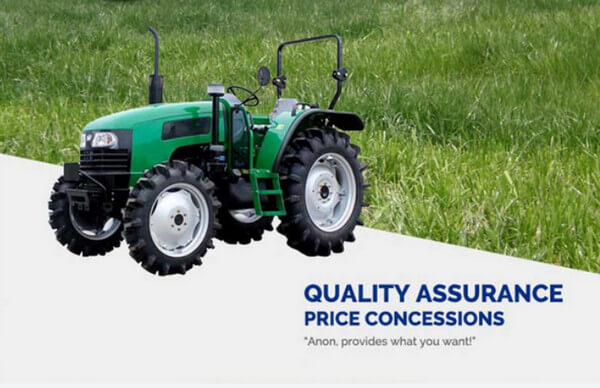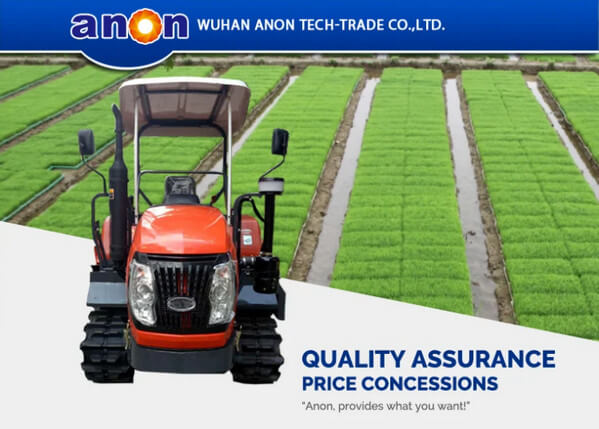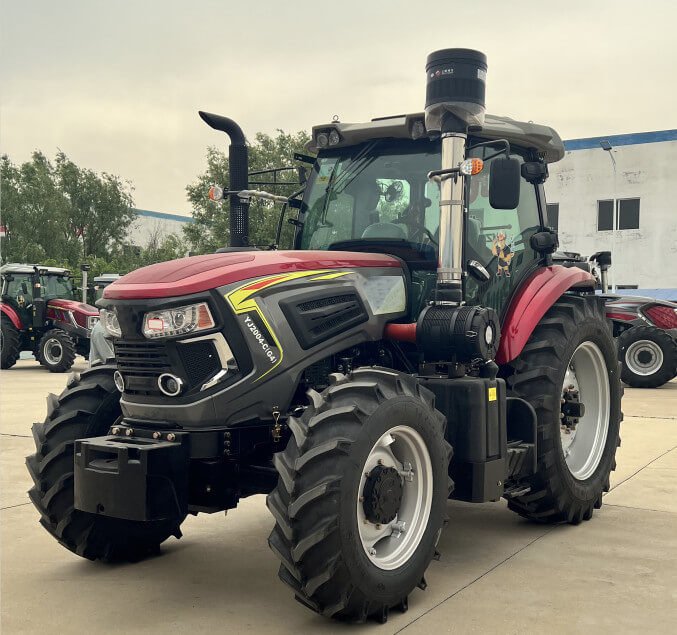Introduction
If you’re looking to choose the best tractor for small farms to improve efficiency but are unsure how to navigate the variety of options available, do not feel that the farm is small and buy a small tractor, don’t miss this article. I’ll introduce you to some factors to consider when selecting a tractor.
Assessing Your Needs
Determine the primary tasks
Before purchasing a tractor, first consider what tasks you need it to perform. If your needs are limited to shallow plowing, tilling small plots of land, planting seeds, spraying pesticides, mowing lawns, or light transportation, a small tractor will suffice for your requirements.
If you need a tractor to work on medium-sized land and also want to use it for harvesting crops and spraying them, a small tractor won’t meet your needs. Consider using a medium tractor instead, which can handle heavier implements and perform heavier hauling.
If small tractors or medium tractors cannot meet your needs, you might want to consider a big tractor. It can accommodate wider farming implements, ensure high-quality work, be cost-effective, and handle large-scale transportation.
Consider the size of your property
You also need to consider the size of your farm. If your farm is too small and the tractor is too large, it can waste resources on maintenance and fuel, and storage space can be an issue. Moreover, oversized tractors on smaller farms may compact the soil and damage crops, affecting their growth.
If you have a large farm but purchase a small tractor or medium tractor, although they are flexible, they will require more time and effort for the same workload compared to a large tractor, resulting in lower efficiency. Additionally, small and medium-sized tractors have limited working ranges, which can lead to uneven operations.
Evaluate the terrain and soil type
In addition to considering the size of your land, you also need to think about the terrain and soil type. If your farmland is hard but flat, you don’t need to worry about getting stuck, so you can choose a wheeled tractor.
However, if your land is wet, soft, or has steep slopes, wheeled tractors, especially small tractors, can easily get stuck. In such cases, you can opt for a crawler tractor because it has a larger contact area with the ground and stronger traction, which largely prevents getting stuck and improves climbing ability.
If you need to work in a paddy field, you can choose a boat tractor or a combination that can float on the water surface, ensuring normal operation in wet conditions. Despite being called a boat tractor, it can also work on dry land.
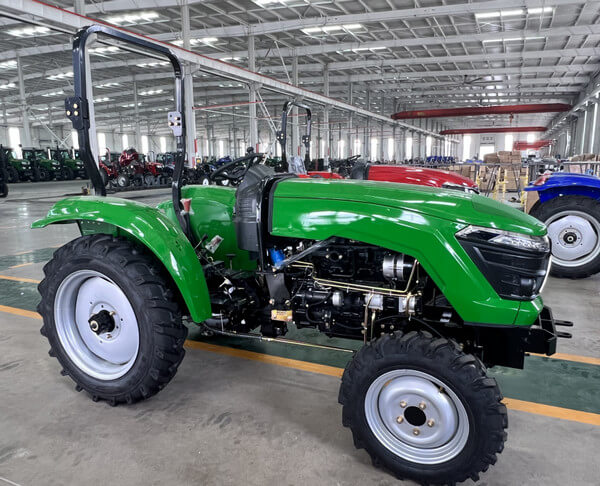
wheeled tractor
Key Features to Consider
Horsepower
When choosing a tractor, it’s important to understand its horsepower. Remember the small tractors, medium tractors, and big tractors I mentioned? They’re categorized by horsepower: Tractors with less than 20 horsepower are small tractors, those between 20 and 50 horsepower are medium tractors, and those over 50 horsepower are big tractors. Generally, higher horsepower means higher efficiency. Horsepower measures the tractor’s output power, calculated by Horsepower = Torque × RPM ÷ 5252. Torque, or rotational force applied to an object, is a key factor in horsepower. So, with the same weight, more horsepower means faster speed and stronger load capacity.
Engine Types
The engine is the tractor’s power unit, converting heat energy from fuel combustion into mechanical energy to drive the tractor during operations. Engines are categorized by fuel type into diesel engines and gasoline engines. Explaining only the tractor engine components might be hard to understand, so I’ll compare them below to clarify their differences and help you make a better choice.
Ignition Method
Gasoline has a high ignition point, is easily volatile, and has a compression ratio (degree of gas compression) between 7-13, so it uses spark plug ignition. Diesel has a low ignition point, is not easily volatile, and has a compression ratio between 16-24, so it uses compression ignition.
Load Capacity
Diesel engines draw in a larger volume of air, burn fuel more completely, and produce higher pressure. Moreover, because diesel is not easily volatile and uses compression ignition, it burns more slowly and has a longer stroke compared to gasoline engines. As I mentioned before, torque relates to force and force arm, so you can see that diesel engines have higher torque. Diesel engines have superior load capacity compared to gasoline engines.
Speed
Due to the excessive pressure generated and the long stroke of diesel engines during operation, high engine speeds can cause violent impacts on internal parts, so diesel tractors generally cannot operate at too high speeds. On the other hand, gasoline engines ignite fuel with spark plugs, making combustion faster and operations quicker, resulting in greater power output. Although gasoline engines have lower torque, they operate at higher speeds, so gasoline tractors are faster than diesel tractors.
Economy
Before discussing the economy of diesel and gasoline engines, you need to understand the power calculation formula: Power = Torque × RPM ÷ 9550. You’ll see that when diesel and gasoline engines have the same power output, gasoline engines consume more fuel than diesel engines. Diesel engines have higher manufacturing costs due to the high precision required for certain parts. Gasoline engines, on the other hand, have electronic components, making their maintenance costs higher than diesel engines.
Engine Cooling Methods
Whether it’s a diesel engine or a gasoline engine, a lot of heat is generated during operation. If not cooled promptly, it can damage engine parts. The two common cooling methods are air cooling and liquid cooling.
Liquid Cooling
Water-cooled engines use water as the cooling medium. There are two cooling methods: one uses water evaporation to dissipate heat and needs constant refilling, and the other circulates coolant through the engine and radiator using a pump. The coolant is then cooled by airflow from the moving machine or a fan. If your work area is near a water source, you can choose this type. Generally, water cooling is more stable.
Air Cooling
Air-cooled engines use air as the cooling medium. Fast-moving air carries away heat from the engine fins. There are two types: natural air cooling and fan-assisted air cooling, which enhances airflow for quicker cooling. These engines have a simpler structure, are easier to maintain, and are a good choice if you are in a water-scarce area.
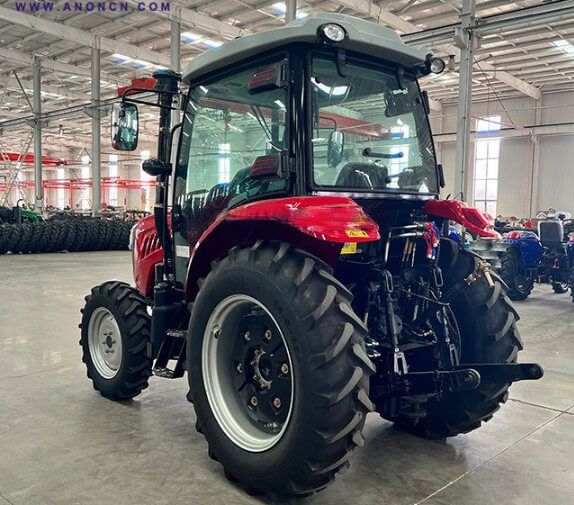
Drive Type (2WD vs. 4WD)
When choosing a wheeled tractor, you need to understand the drive type. It’s not just walking tractors that are two-wheel drive. Some tractors have four wheels, but only the front or rear wheels provide power and traction, also called two-wheel drive. Only tractors where all four wheels provide power and traction are four-wheel drive. Two-wheel drive tractors are more flexible, easier to maneuver, simpler, and cheaper. Four-wheel drive tractors offer better traction and stability, making them suitable for complex terrain and tough working conditions.
Conclusion
I believe that after my introduction, you should have some ideas on how to choose a tractor. You can pick the best tractor for your small farm based on your conditions and budget. ANON has been established for over ten years, specializing in exporting agricultural machinery. We have a wide variety of tractors and matching implements, so you can choose some implements to use with your tractor.
FAQ
What size tractor is best for 1 acre of land?
Small properties (1-5 acres): If you need to tend a garden, mow a yard, or maintain small landscaping projects, a small machine, such as a subcompact tractor, will suffice. These machines are ideal for light tasks like clearing snow or grading a gravel driveway.
What size tractor do I need for my farm?
For larger farms, you’ll need a tractor with a power setting of 100 horsepower or higher, with 200 or 300 horsepower being ideal. You’ll also need to consider the terrain: if your terrain is rocky and sloping, you’ll need a more powerful tractor than if your farm is on flat ground.


